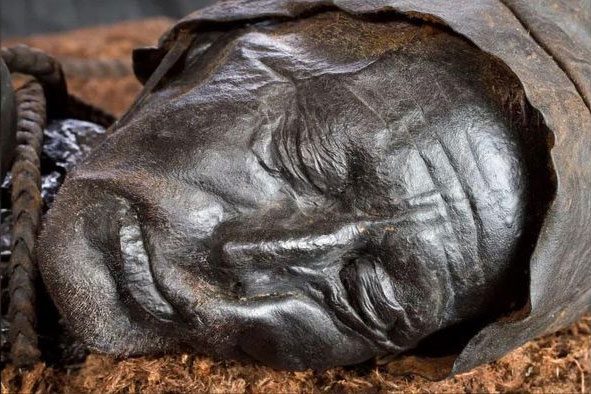A new study reveals that “Tollund Man,” a famous ancient Danish sacrificial figure, had his last meal consisting of porridge and fish.
The lead researcher, Nina Nielsen, an archaeologist and head of research at the Silkeborg Museum in Denmark, stated: “We were able to reconstruct Tollund Man’s last meal with remarkable detail. This is quite fascinating because it brings us closer to what actually happened 2,400 years ago.”
The remains of this ancient man were discovered in 1950 by a family near the village of Tollund while they were digging for fuel in a peat bog. His body – along with the noose around his neck – was remarkably well-preserved, leading the family to believe he was a murder victim.
“Tollund Man” had been preserved for so long due to the low oxygen environment of the peat bog. Over the years, studies have determined that he died sometime between 405 BCE and 380 BCE, during the early Iron Age in Denmark, and that he was likely 30 to 40 years old at the time of death. Researchers noted in the study that “Tollund Man” had been hanged and placed in a sleeping position in a peat bog – a “remarkable treatment method.”

The body of Tollund Man has been well preserved in the peat.
A study in 1951 of Tollund Man’s intestines revealed that he had consumed porridge for his last meal. However, intestinal analysis techniques have since improved, prompting a group of researchers to take a new look at Tollund Man.
The Last Meal
By examining a segment of Tollund Man’s colon that had been previously cut and preserved, the research team found that the 1951 study was quite accurate but had overlooked some details, including the component ratios of the meal.
The new analysis showed that by weight, the porridge consisted of 85% barley, 9% wild plants, and 5% flax (Linum usitatissimum). The remaining 1% included various seeds, including seeds from corn cockle (Spergula arvensis), gold of pleasure (Camelina sativa), and three types of wetland plants: marsh willowherb (Epilobium palustre), soft rush (Juncus conglomeratus / effusus), and marsh violet (Viola palustris). Furthermore, the research team found pollen from barley, grass, and dryland plants.
The researchers noted: “Barley and flax grow in different seasons, so the pale wild plant seeds were likely harvested alongside the barley.”
Besides fish, these are the types of food Tollund Man consumed and their corresponding amounts: 1) Barley, 2) pale fish, 3) flax, 4) black seaweed, 5) sand, 6) gold of pleasure, 7) fat hen, 8) corn cockle, 9) nettle, and 10) another corn cockle.
“Typically, when farmers clean and sift grains, small weed seeds are collected with them, such as seeds from the pale plant that may fall out,” Nielsen said. However, it seems that in Tollund Man’s case, this waste – which included small pieces of charcoal, burned food husks (indicating that the porridge was cooked in a clay pot), and grains of sand – was added to the porridge, possibly as part of a ritual.
A chemical and protein analysis indicated that Tollund Man consumed a fatty fish along with the porridge approximately 12 to 24 hours before his death. Researchers pointed out that while people in Iron Age Denmark did eat fish, it was not a significant part of their diet. Additional analyses revealed parasitic eggs that Tollund Man may have contracted from eating raw or undercooked meat and drinking contaminated water.
The researchers stated that the circumstances leading to Tollund Man’s death remain a mystery, but the actual meal provides clues.
Nielsen remarked: “Our understanding of Tollund Man is that he was sacrificed in a ritual. During this Iron Age, wetlands were often used for ritual activities.”
Previous analyses revealed that although Tollund Man likely died from asphyxiation, his neck was not broken. It is possible that some rituals took place before Tollund Man was hanged, including having his last meal.
The study “expands our knowledge of diet and meal preparation during the Iron Age in Denmark,” said Albert Zink, head of the Institute for Mummy Research at Eurac Research in Bolzano, Italy. He compared this study of the “last meal” to similar research on Ötzi the Iceman, who lived about 5,300 years ago in the Alps.




















































